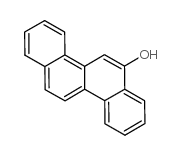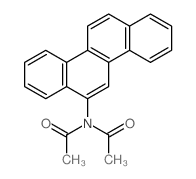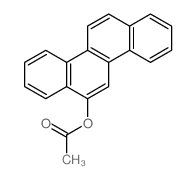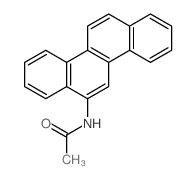2642-98-0
| Name | chrysen-6-amine |
|---|---|
| Synonyms |
Chrysen-6-ylamine
6-Amino-chrysen Chrysen-6-ylamin 6-AMINOCHRYSENE Chrysenex Chrysen-6-amine 6-Amc Chrysonex 6-chrysenylamine 6-Chrysenamine MFCD00003699 chrysene-6-ylamine EINECS 220-149-7 |
| Description | 6-Aminochrysene (6-Aminochrysene) is an aromatic amine used as a chemotherapeutic agent in the treatment of splenomegaly, myeloid leukemia, and breast cancer. |
|---|---|
| Related Catalog | |
| In Vitro | 6-Aminochrysene inhibits the hydroxylation of aniline, 0-demethylation of p-nitroanisole, and N-demethylation of aminopyrine by rat liver microsomes. Pre-treatment of rats with 6-aminochrysene markedly decreases the N-demethylation in vitro but significantly increases the hydroxylation and the 0-demethylation[1]. |
| In Vivo | 6-Aminochrysene is an inhibitor of the growth of several solid experimental tumours in vivo and has a cancerostatic effect on human breast cancer[1]. Long term topical skin application of 6-Aminochrysene to mice induces development of benign skin tumors after 3 months and of skin malignancies after 7 months. Female mice respond earlier than males. Induction of skin tumors is more rapid when 6-Aminochrysene is applied ventrally instead of dorsally. Urinary excretion is about twice as high after skin application than after oral administration[2]. |
| Animal Admin | Rats: Male CD rats are pre-treated with 25, 50 and 100 mg/kg of 6-Aminochrysene intraperitoneally once daily for 3 consecutive days before sacrifice, which is performed 24 h after the last administration. Controls receive only the solvent[1]. |
| References |
[2]. Lambelin G, et al. Carcinogenicity of 6-aminochrysene in mice. Eur J Cancer. 1975 May;11(5):327-34. |
| Density | 1.3±0.1 g/cm3 |
|---|---|
| Boiling Point | 501.2±19.0 °C at 760 mmHg |
| Melting Point | 209-211 °C(lit.) |
| Molecular Formula | C18H13N |
| Molecular Weight | 243.303 |
| Flash Point | 286.9±16.8 °C |
| Exact Mass | 243.104797 |
| PSA | 26.02000 |
| LogP | 4.63 |
| Vapour Pressure | 0.0±1.3 mmHg at 25°C |
| Index of Refraction | 1.814 |
| Storage condition | 2-8°C |
Synonym:6-Chrysenamin Section 2 - COMPOSITION, INFORMATION ON INGREDIENTS
Risk Phrases: 40 Section 3 - HAZARDS IDENTIFICATION EMERGENCY OVERVIEW
Limited evidence of a carcinogenic effect.The toxicological properties of this material have not been fully investigated. Potential Health Effects Eye: May cause eye irritation. Skin: May cause skin irritation. Ingestion: May cause irritation of the digestive tract. The toxicological properties of this substance have not been fully investigated. Inhalation: May cause respiratory tract irritation. The toxicological properties of this substance have not been fully investigated. Chronic: No information found. Section 4 - FIRST AID MEASURES Eyes: Flush eyes with plenty of water for at least 15 minutes, occasionally lifting the upper and lower eyelids. Get medical aid. Skin: Get medical aid. Flush skin with plenty of water for at least 15 minutes while removing contaminated clothing and shoes. Wash clothing before reuse. Ingestion: Never give anything by mouth to an unconscious person. Get medical aid. Do NOT induce vomiting. If conscious and alert, rinse mouth and drink 2-4 cupfuls of milk or water. Inhalation: Remove from exposure and move to fresh air immediately. If not breathing, give artificial respiration. If breathing is difficult, give oxygen. Get medical aid. Notes to Physician: Section 5 - FIRE FIGHTING MEASURES General Information: As in any fire, wear a self-contained breathing apparatus in pressure-demand, MSHA/NIOSH (approved or equivalent), and full protective gear. During a fire, irritating and highly toxic gases may be generated by thermal decomposition or combustion. Extinguishing Media: Use agent most appropriate to extinguish fire. Use water spray, dry chemical, carbon dioxide, or appropriate foam. Section 6 - ACCIDENTAL RELEASE MEASURES General Information: Use proper personal protective equipment as indicated in Section 8. Spills/Leaks: Clean up spills immediately, observing precautions in the Protective Equipment section. Sweep up, then place into a suitable container for disposal. Avoid generating dusty conditions. Provide ventilation. Section 7 - HANDLING and STORAGE Handling: Wash thoroughly after handling. Remove contaminated clothing and wash before reuse. Use with adequate ventilation. Minimize dust generation and accumulation. Avoid contact with eyes, skin, and clothing. Keep container tightly closed. Avoid ingestion and inhalation. Storage: Store in a tightly closed container. Store in a cool, dry, well-ventilated area away from incompatible substances. Section 8 - EXPOSURE CONTROLS, PERSONAL PROTECTION Engineering Controls: Facilities storing or utilizing this material should be equipped with an eyewash facility and a safety shower. Use adequate ventilation to keep airborne concentrations low. Exposure Limits CAS# 2642-98-0: Personal Protective Equipment Eyes: Wear appropriate protective eyeglasses or chemical safety goggles as described by OSHA's eye and face protection regulations in 29 CFR 1910.133 or European Standard EN166. Skin: Wear appropriate protective gloves to prevent skin exposure. Clothing: Wear appropriate protective clothing to prevent skin exposure. Respirators: A respiratory protection program that meets OSHA's 29 CFR 1910.134 and ANSI Z88.2 requirements or European Standard EN 149 must be followed whenever workplace conditions warrant respirator use. Section 9 - PHYSICAL AND CHEMICAL PROPERTIES Physical State: Powder Color: brown Odor: None reported. pH: Not available. Vapor Pressure: Not available. Viscosity: Not available. Boiling Point: Not available. Freezing/Melting Point: 209.00 - 211.50 deg C Autoignition Temperature: Not applicable. Flash Point: Not applicable. Explosion Limits, lower: Not available. Explosion Limits, upper: Not available. Decomposition Temperature: Solubility in water: Specific Gravity/Density: Molecular Formula: C18H13N Molecular Weight: 243.0977 Section 10 - STABILITY AND REACTIVITY Chemical Stability: Stable under normal temperatures and pressures. Conditions to Avoid: Incompatible materials, dust generation, excess heat, strong oxidants. Incompatibilities with Other Materials: Oxidizing agents. Hazardous Decomposition Products: Nitrogen oxides, carbon monoxide, irritating and toxic fumes and gases, carbon dioxide. Hazardous Polymerization: Has not been reported. Section 11 - TOXICOLOGICAL INFORMATION RTECS#: CAS# 2642-98-0: GC0500000 LD50/LC50: Not available. Carcinogenicity: 6-Aminochrysene - Not listed by ACGIH, IARC, or NTP. Other: See actual entry in RTECS for complete information. Section 12 - ECOLOGICAL INFORMATION Section 13 - DISPOSAL CONSIDERATIONS Dispose of in a manner consistent with federal, state, and local regulations. Section 14 - TRANSPORT INFORMATION IATA Not regulated as a hazardous material. IMO Not regulated as a hazardous material. RID/ADR Not regulated as a hazardous material. Section 15 - REGULATORY INFORMATION European/International Regulations European Labeling in Accordance with EC Directives Hazard Symbols: XN Risk Phrases: R 40 Limited evidence of a carcinogenic effect. Safety Phrases: S 28A After contact with skin, wash immediately with plenty of water. S 36/37 Wear suitable protective clothing and gloves. S 37 Wear suitable gloves. S 45 In case of accident or if you feel unwell, seek medical advice immediately (show the label where possible). WGK (Water Danger/Protection) CAS# 2642-98-0: No information available. Canada None of the chemicals in this product are listed on the DSL/NDSL list. CAS# 2642-98-0 is not listed on Canada's Ingredient Disclosure List. US FEDERAL TSCA CAS# 2642-98-0 is not listed on the TSCA inventory. It is for research and development use only. SECTION 16 - ADDITIONAL INFORMATION N/A |
CHEMICAL IDENTIFICATION
HEALTH HAZARD DATAACUTE TOXICITY DATA
MUTATION DATA
|
| Symbol |

GHS07 |
|---|---|
| Signal Word | Warning |
| Hazard Statements | H302 |
| Personal Protective Equipment | dust mask type N95 (US);Eyeshields;Gloves |
| Hazard Codes | Xn: Harmful; |
| Risk Phrases | 22 |
| Safety Phrases | S45-S36/37/39-S26 |
| RIDADR | NONH for all modes of transport |
| WGK Germany | 3 |
| RTECS | GC0500000 |
| HS Code | 2921499090 |
|
~99% 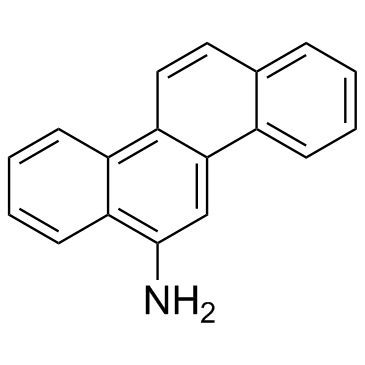
2642-98-0 |
| Literature: MacCrehan, W. A.; May, W. E.; Yang, S. D.; Benner, B. A. Analytical Chemistry, 1988 , vol. 60, # 3 p. 194 - 199 |
|
~% 
2642-98-0 |
| Literature: Ciba Patent: CH170447 , 1934 ; |
|
~% 
2642-98-0 |
| Literature: Newman; Cathcart Journal of Organic Chemistry, 1940 , vol. 5, p. 618,620 |
| Precursor 4 | |
|---|---|
| DownStream 5 | |
| HS Code | 2921499090 |
|---|---|
| Summary | 2921499090 other aromatic monoamines and their derivatives; salts thereof VAT:17.0% Tax rebate rate:9.0% Supervision conditions:none MFN tariff:6.5% General tariff:30.0% |




